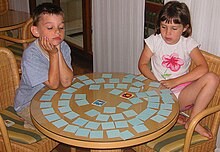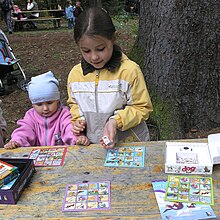Child's play
As Children's is defined as the activity of the child , to participate in the innate curiosity and desire to play instinct Following himself acquainted, explores his environment and his roles developed in society.
In terms of developmental psychology , a distinction is made between different types and forms of play in children's play - as in play in general:
- Functional games with your own body and with objects (such as the hickelbox game , marble game ),
- Fiction games, i.e. games of interpretation and illusion,
- Role playing , in particular, as a free-associative group matches and as a regulated board games are taking and to which the game connects seamlessly adult a wide space in the socialization.
Based on the objective game, the following differ in children's games:
- Reception games,
- Manufacturing games,
- Construction games .
For the development of the child, psychologically and pedagogically different types and forms have proven to be particularly valuable, while others have proven to be extremely harmful. These findings are not always taken into account in the craft and industrial toy design and manufacture of toys , play equipment and games and should be taken into account when buying toys for the child.

Evaluation of child play behavior

Children's play and play behavior by children should not be misunderstood as worthless flirting or pastime out of boredom . The derogatory term "gimmick" for the game that is not explicitly learning-oriented is therefore not appropriate from the point of view of playing. Children's play already finds its meaning out of itself. However, it also has an important function in mental development.
- Thus, perceptual skills, motor skills and intelligence skills are acquired in children's play, namely on
- convergent (inferential) and
- divergent (creative, intuitive) area.
- During the socialization process and personal development , tensions and problems can be reduced and overcome.
- Social relationships and values can be tried out and practiced in playful action.
A successful development would, however, be detrimental to games that do not activate the child enough and are used as a convenient escape from reality.
Critical children's games
Play pedagogy distinguishes between “free” (play designed by the children on their own initiative) and “controlled” (play influenced by educators or therapists for specific purposes).
Even free children's play does not take place in value-free spaces and its effects on the child's psyche are not without consequences: play can have lasting positive and negative learning effects on the child's social behavior, his further playfulness and his overall development.
In a discussion forum, the game didacticians SA Warwitz and A. Rudolf present several such types of play that can deeply hurt sensitive child souls, cause fears, damage the natural social structure and cause permanent disenchantment with games. These are primarily the categories of so-called heme games and certain forms of war games :
The games of hammers range from torturing animals (tying a cat's clattering cans to the tail or letting a captured bird fly on a string) to games that require unsuspecting children to make hurtful gestures of humility or exclude them from the play group amid the mocking laughter of fellow players.
The war games , which are very popular with children of all ages, are to be viewed critically in another way . The assessment of war toys (e.g. replicas of rifles and pistols) and war games is controversial in the professional world. The purchase of war toys is therefore often seen as problematic by parents and educators. The appropriate classification and assessment of this type of game requires the responsible and often unfounded adults to have expert knowledge of the symbol game and an unbiased, non-ideological examination of the special game idea , in particular a ability to differentiate from the so-called killer games .
Children's games (selection)


Musical and rhythmic children's games
These include above all
- Counting rhymes
- Round games , such as thalers, thalers, you have to hike or bunnies in the pit
- Moving singing games such as A Little Sailor
- Clapping games
"Musical movement games have always been part of the children's play repertoire. In the past, they could be played outdoors in meadows, courtyards and streets. These happy wind and weather locations are hardly available to our children today. But where they are newly created or still available , old and new dance and movement games are played again in the different seasons. "
The moving Singspiel in particular enjoys great popularity in completely new contexts due to its simple melodies and harmonies, for example as a Mallorca hit ( The Red Horse ) or as a YouTube phenomenon ( Little Shark ).
Movement games
Movement games are joyful actions that develop physical and mental abilities and dexterity, for example
- To catch
- Who is afraid of the black man?
- Blindman's Buff
- Hiding with striking (clapping)
- Sack race
- Jumping rope
- Rubber twist
- Egg running
More games
- Finger games, also string games
- Games of skill
- Partner choice and replacement
- Imitation and representation
- Series games
- Betting, guessing and catching games
- Circle games
- Language games
- Social games
- Board games
- Didactic games
Further meaning
A children's game is also colloquially referred to as something that is very easy to understand and handle (“It's a children's game”).
See also
literature
- Imbke Behnken: Urban play and street worlds . Contemporary witnesses and documents about childhood at the beginning of the 20th century . Weinheim: Juventa-Verlag 2006.
- Johannes Bilstein, Matthias Winzen, Christoph Wulf (Ed.): Anthropology and pedagogy of the game . Weinheim Beltz Publishing House. 2005.
- Franz Magnus Böhme (Hrsg.): German children's song and children's game : folk traditions from all countries of the German tongue, collected, sorted and with indication of the sources, explanatory notes and the associated melodies. Unchanged reprint. Leipzig: Breitkopf & Härtel 1924.
- Wolfgang Einsiedler: The children's game. On the pedagogy and psychology of children's play . 3rd edition, Bad Heilbrunn 1999, ISBN 3-7815-0977-X .
- Andreas Flitner (Ed.): The children's game . Texts. 2nd edition, Piper, Munich 1974.
- Hans Mogel: Psychology of children's play . 3rd edition Heidelberg: Springer Medizin Verlag 2008 ISBN 978-3-540-46623-9 .
- Hein Retter, Children's Play and Childhood in East and West. Play promotion, play research and play organization in individual fields of practice - with special consideration of the kindergarten . Bad Heilbrunn: Klinkhardt 1991.
- Hein Retter: Child's play between media and commerce. On the changing game in contemporary society. Interdisciplinary approaches . In: K. Richter, T. Trautmann (ed.): Being a child in the media society. Weinheim: Deutscher Studien Verlag 2002, pp. 283-304.
- Hein Retter: The importance of play in a changing children's world . In: Irmischer, Hammer, Wendler, Hoffmann (eds.): Playing in the psychomotor system . Edited by the Action Group Psychomotorik eV Lemgo: Verlag Action Group Literature and Media 2004, pages 29–40.
- Anita Rudolf, Siegbert A. Warwitz: Playing - rediscovered. Basics-suggestions-help . Herder Verlag, Freiburg 1982
- Siegbert A. Warwitz, Anita Rudolf: From the sense of playing. Reflections and game ideas . 4th edition, Verlag Schneider, Baltmannsweiler 2016, ISBN 978-3-8340-1664-5 , pages 126-145.
- Ingeborg Weber-Kellermann, Regine Falkenberg: What we played. Memories of childhood . Insel-Verlag, Frankfurt / M. 1981.
- Gisela Wegener-Spöhring: The meaning of 'war toys' in the world of elementary school children . In: Zf Päd. 32 (1986) p. 797-810
- Ignaz Vinzenz Zingerle: The German children's game in the Middle Ages . Wagner, Innsbruck 1873 ( digitized version )
Web links
- Youth games for relaxation and amusement . Volumes: Boys 'Games (1846), Girls' Games (1848)
- several articles on violent and war toys
- Why peace games are controversial , by Christin Severin in the NZZ , accessed on February 20, 2016
Individual evidence
- ^ Siegbert A. Warwitz, Anita Rudolf: What can play can do , In: This: From the sense of playing. Reflections and game ideas . 4th edition, Verlag Schneider, Baltmannsweiler 2016, pp. 22-25
- ↑ J. Bilstein, M., Winzen, CH., Wulf (Ed.): Anthropology and pedagogy of play . Weinheim 2005
- ^ Siegbert A. Warwitz, Anita Rudolf: What playing can achieve . In: Dies: On the meaning of play. Reflections and game ideas . 4th edition, Verlag Schneider, Baltmannsweiler 2016, pages 22-25
- ↑ Wolfgang Einsiedler: The children's game. On the pedagogy and psychology of children's play . 3rd edition, Bad Heilbrunn 1999
- ^ Siegbert A. Warwitz, Anita Rudolf: From the sense of playing. Reflections and game ideas . 4th edition, Verlag Schneider, Baltmannsweiler 2016, pages 126-145 and 152-160
- ^ Siegbert A. Warwitz, Anita Rudolf: Controversial forms of play , In: Dies .: Vom Sinn des Spielens. Reflections and game ideas . 4th edition, Verlag Schneider, Baltmannsweiler 2016, pages 126–145
- ↑ Gisela Wegener-Spöhring: The meaning of 'war toys' in the world of elementary school children . In: Z. f. Ped. 32 (1986), pp. 797-810
- ↑ What is it anyway: "War Toys"? Berghof Foundation, accessed on January 21, 2013 (Excerpts from Jürgen Fritz: Video games between fascination, technology and commerce . In: Ders. (Ed.): Programmiert zum Kriegspiele. Weltbilder und Bilderwelten im Videogame . Bonn 1988, p. 82ff. As PDF (8 KB, 5 pages) available ).
- ^ Siegbert A. Warwitz, Anita Rudolf: On the symbolism of children's play . In: Dies .: The sense of playing. Reflections and game ideas . 4th edition, Verlag Schneider, Baltmannsweiler 2016, p. 126
- ↑ M. & W. Jehn: Let's go on a journey - musical children's games from all over the world. Worpsweder Musikwerkstatt, 2000
- ↑ Children's song conquers Mallorca and the ski huts: Party cracker The Red Horse ( Memento from April 8, 2009 in the Internet Archive )
- ↑ Simple Gassenhauer ( Memento from July 5, 2008 in the Internet Archive ) on Vanityfair.de


